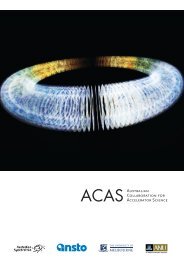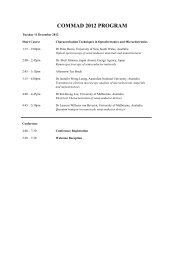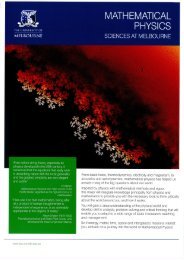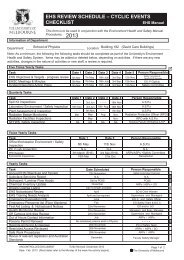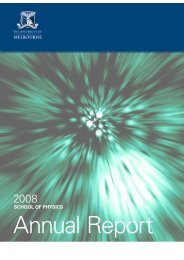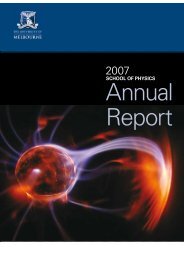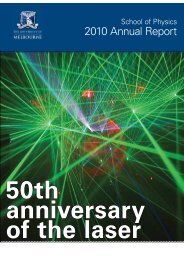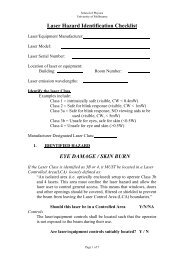Annual Report 2011-2012.pdf - School of Physics - University of ...
Annual Report 2011-2012.pdf - School of Physics - University of ...
Annual Report 2011-2012.pdf - School of Physics - University of ...
Create successful ePaper yourself
Turn your PDF publications into a flip-book with our unique Google optimized e-Paper software.
MELBOURNE MATERIALS INSTITUTE (MMI)<br />
The <strong>School</strong> <strong>of</strong> <strong>Physics</strong> is the host department <strong>of</strong> the interdisciplinary<br />
Melbourne Materials Institute (MMI). The MMI is one <strong>of</strong> six<br />
interdisciplinary research institutes, established by the <strong>University</strong> to<br />
foster new research collaborations internally and externally to solve major<br />
social, economic and environmental challenges.<br />
The MMI has brought together researchers across the faculties <strong>of</strong><br />
Science, Engineering, MDHS and Arts through seed funding, networking<br />
events, and research workshops. The excellence <strong>of</strong> materials research<br />
at the <strong>University</strong> is exemplified by the highest citation rate in materials<br />
science in Australia 1 and two researchers in the Thomson Reuters<br />
ranking <strong>of</strong> Top 100 Materials Scientists (Pr<strong>of</strong>essor Frank Caruso<br />
#17, Associate Pr<strong>of</strong>essor Rachel Caruso #21). Early career materials<br />
researchers have also excelled, with Dr Georgina Such awarded a L’Oreal<br />
Women in Science Fellowship in <strong>2011</strong>. PhD student Brandon MacDonald<br />
(Bio21 Institute) was selected as one <strong>of</strong> sixteen <strong>2011</strong> Fresh Scientists<br />
for his work to lower the cost <strong>of</strong> renewable energy by making solar cells<br />
from nanocrystal inks.<br />
Over the last two years, the collective expertise <strong>of</strong> Melbourne<br />
researchers has resulted in funding success with over $13.6 million in<br />
grants from the ARC. A further $13.8 million was awarded by state and<br />
federal governments for research into materials processing for water<br />
treatment, carbon dioxide capture and printable solar cells.<br />
The MMI supports materials research through the following themes:<br />
energy, materials conservation, materials for medicine, materials<br />
processing, and quantum and nanophotonic materials. Significant funding<br />
is provided through seed grants ($430,000 provided by the MMI to 13<br />
projects over <strong>2011</strong>-2012), as well as financial and administrative support<br />
for workshops, publications and a visitor program. The visitor program<br />
has seen visits and new collaborations form with: A/Pr<strong>of</strong> Eva Harth<br />
(Vanderbilt <strong>University</strong>), Pr<strong>of</strong> Christ van de Walle (UCSB), Pr<strong>of</strong> David<br />
Awschalom (UCSB), Dr Robert Miller (IBM), Pr<strong>of</strong> Kenneth Dawson<br />
(<strong>University</strong> College Dublin) and Dr Xavier Sauvage (CNRS, France). An<br />
array <strong>of</strong> international experts visited the <strong>University</strong> in January 2012 as<br />
part <strong>of</strong> the MMI symposium on diamond photonics that was co hosted<br />
with Harvard <strong>University</strong>.<br />
A highlight <strong>of</strong> the research program has been the successful implantation<br />
<strong>of</strong> an early prototype bionic eye by Bionic Vision Australian. The MMI<br />
and the <strong>School</strong> <strong>of</strong> <strong>Physics</strong> are members <strong>of</strong> this national consortium,<br />
fabricating a high-density diamond electrode array for the high acuity<br />
vision prototype.<br />
A major new pilot program to support materials research<br />
infrastructure was initiated by the MMI in 2012. The program<br />
provides technical support and academic leadership for key<br />
infrastructure platforms across the <strong>University</strong>, as well as at the<br />
Melbourne Centre for Nan<strong>of</strong>abrication (MCN). The <strong>University</strong><br />
is a partner <strong>of</strong> the MCN and the MMI has facilitated increased<br />
utilisation <strong>of</strong> the facilities over the past 18 months.<br />
The MMI is fostering the next generation <strong>of</strong> materials<br />
researchers through the MMI-CSIRO Materials Science<br />
PhD Scholarship Program. Through joint supervision with<br />
CSIRO, 14 students have received scholarship ‘top-ups’ to<br />
$30,000p.a. The program provides increased collaboration<br />
between <strong>University</strong> researchers and the CSIRO as well as<br />
excellent training for the students.<br />
The MMI public lecture series has covered a broad range<br />
<strong>of</strong> topics. In <strong>2011</strong> Associate Pr<strong>of</strong>essor Eva Harth from<br />
Vanderbilt <strong>University</strong> presented on her work on nanosponges<br />
for targeted cancer treatment. Later in the year Pr<strong>of</strong>essor<br />
Peter Scales spoke about the materials processing issues<br />
relating to water recycling as part <strong>of</strong> the public event on water<br />
recycling – From Toilet to Tap. He was joined by Greens MP<br />
Adam Bandt and Pr<strong>of</strong>essor Michael Porter (Alfred Deakin<br />
Research Institute) who provided perspectives on the<br />
associated political and social issues. In 2012, the MMI held<br />
public lectures on diamonds for the quantum age (Pr<strong>of</strong>essor<br />
David Awschalom, UCSB), medical bionics (Pr<strong>of</strong>essor Robert<br />
Shepherd, Bionics Institute) and the science <strong>of</strong> conserving<br />
Indigenous Australian art (A/Pr<strong>of</strong>essor Robyn Sloggett,<br />
Dr Petronella Nel from the <strong>University</strong> <strong>of</strong> Melbourne and<br />
Indigenous Australian artists from Warmun Art Centre).<br />
Artist’s impression <strong>of</strong> the current generation <strong>of</strong> the BVA epiretinal<br />
device, tacked in positioned over the macular. (credit: David<br />
Garrett)<br />
Ngalangangpum <strong>School</strong>, Nancy Nodea. © Copyright in this<br />
artwork and text remains with the Artist and Warmun Art<br />
Centre respectively<br />
www.physics.unimelb.edu.au 21




